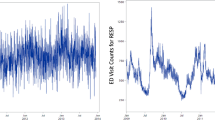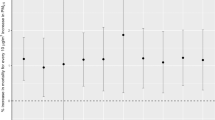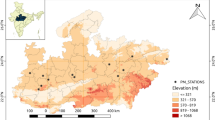Abstract
A hybrid approach is proposed to estimate exposure to fine particulate matter (PM2.5) at a given location and time. This approach builds on satellite-based aerosol optical depth (AOD), air pollution data from sparsely distributed Environmental Protection Agency (EPA) sites and local time–space Kriging, an optimal interpolation technique. Given the daily global coverage of AOD data, we can develop daily estimate of air quality at any given location and time. This can assure unprecedented spatial coverage, needed for air quality surveillance and management and epidemiological studies. In this paper, we developed an empirical relationship between the 2 km AOD and PM2.5 data from EPA sites. Extrapolating this relationship to the study domain resulted in 2.3 million predictions of PM2.5 between 2000 and 2009 in Cleveland Metropolitan Statistical Area (MSA). We have developed local time–space Kriging to compute exposure at a given location and time using the predicted PM2.5. Daily estimates of PM2.5 were developed for Cleveland MSA between 2000 and 2009 at 2.5 km spatial resolution; 1.7 million (∼79.8%) of 2.13 million predictions required for multiyear and geographic domain were robust. In the epidemiological application of the hybrid approach, admissions for an acute exacerbation of chronic obstructive pulmonary disease (AECOPD) was examined with respect to time–space lagged PM2.5 exposure. Our analysis suggests that the risk of AECOPD increases 2.3% with a unit increase in PM2.5 exposure within 9 days and 0.05° (∼5 km) distance lags. In the aggregated analysis, the exposed groups (who experienced exposure to PM2.5 >15.4 μg/m3) were 54% more likely to be admitted for AECOPD than the reference group. The hybrid approach offers greater spatiotemporal coverage and reliable characterization of ambient concentration than conventional in situ monitoring-based approaches. Thus, this approach can potentially reduce exposure misclassification errors in the conventional air pollution epidemiology studies.
This is a preview of subscription content, access via your institution
Access options
Subscribe to this journal
Receive 6 print issues and online access
$259.00 per year
only $43.17 per issue
Buy this article
- Purchase on Springer Link
- Instant access to full article PDF
Prices may be subject to local taxes which are calculated during checkout



Similar content being viewed by others
References
Davidson CI, Phalen R, Solomon P . Airborne particulate matter and human health: a review. Aerosol Sci Technol 2005; 39: 737–749.
Jia XF, Song XM, Shima M, Tamura K, Deng FR, Guo XB . Effects of fine particulate on heart rate variability in Beijing: a panel study of healthy elderly subjects. Int Arch Occup Environ Health 2012; 85: 97–107.
Gualtieri M, Ovrevik J, Mollerup S, Asare N, Longhin E, Dahlman HJ et al. Airborne urban particles (Milan winter-PM2.5) cause mitotic arrest and cell death: effects on DNA, mitochondria, AhR binding and spindle organization. Mutat Res 2011; 713: 18–31.
Murrell RN, Gibson JE . Brevetoxin 2 alters expression of apoptotic, DNA damage, and cytokine genes in Jurkat cells. Hum Exp Toxicol 2011; 30: 182–191.
Nikasinovic L, Just J, Sahraoui F, Seta N, Grimfeld A, Momas I . Nasal inflammation and personal exposure to fine particles PM2.5 in asthmatic children. J Allergy Clin Immunol 2006; 117: 1382–1388.
O'Donnell R, Breen D, Wilson S, Djukanovic R . Inflammatory cells in the airways in COPD. Thorax 2006; 61: 448–454.
Pope CA, Dockery DW, Kanner RE, Villegas GM, Schwartz J . Oxygen saturation, pulse rate, and particulate air pollution—a daily time-series panel study. Am J Resp Crit Care Med 1999; 159: 365–372.
Kumar N . Uncertainty in the relationship between criteria pollutants and low birth weight in Chicago. Atmos Environ 2012; 49: 171–179.
Kumar N . What can affect AOD–PM2.5 association? Environ Health Perspect 2010; 118: A109–A110.
Ott DK, Kumar N, Peters TM . Passive sampling to capture spatial variability in PM10–2.5. Atmos Environ 2008; 42: 746–756.
Klepeis NE, Nelson WC, Ott WR, Robinson JP, Tsang AM, Switzer P et al. The National Human Activity Pattern Survey (NHAPS): a resource for assessing exposure to environmental pollutants. J Expo Anal Environ Epidemiol 2001; 11: 231–252.
Özkaynak H, Baxter L, Dionisio K, Burke J . Air pollution exposure prediction approaches used in air pollution epidemiology studies. J Expos Sci Environ Epidemiol 2013 (forthcoming).
Chu DA, Kaufman YJ, Ichoku C, Remer LA, Tanre D, Holben BN . Validation of MODIS aerosol optical depth retrieval over land. Geophys Res Lett 2002; 29.
Li C, Lau AK-H, Mao JT, Chu DA . Retrieval, validation and application of 1-km resolution aerosol optical depth from MODIS data over HongKong. Trans Geosc Remote Sens 2005; 43: 2650–2658.
Choi Y, Wang Y, Zeng T, Cunnold D, Yang ES, Martin R et al. Springtime transitions of NO2, CO, and O3 over North America: model evaluation and analysis. J Geophys Res Atmos 2008; 113.
Huang M, Carmichael GR, Spak SN, Adhikary B, Kulkarni S, Cheng Y et al. Multi-scale modeling study of the source contributions to near-surface ozone and sulfur oxides levels over California during the ARCTAS-CARB period. Atm Chem Phys 2011; 11: 3173–3194.
van Donkelaar A, Martin RV, Brauer M, Kahn R, Levy R, Verduzco C et al. Global estimates of ambient fine particulate matter concentrations from satellite-based aerosol optical depth: development and application. Environ Health Perspect 2010; 118: 847–855.
Zhang Q, Streets DG, Carmichael GR, He KB, Huo H, Kannari A et al. Asian emissions in 2006 for the NASA INTEX-B mission. Atmos Chem Phys 2009; 9: 5131–5153.
Liang D, Kumar N . Time–space Kriging to address the spatial misalignment, in the large datasets. Atmos Environ 2013; 72: 60–69.
Kumar N . What can affect AOD–PM2.5 association? Environ Health Perspect 2010; 118: A2–A3.
Schwartz J . Air pollution and hospital admissions for respiratory disease. Epidemiology 1996; 7: 20–28.
Zanobetti A, Schwartz J . The effect of particulate air pollution on emergency admissions for myocardial infarction: a multicity case-crossover analysis. Environ Health Perspect 2005; 113: 978.
Luís Ferreira Braga A, Zanobetti A, Schwartz J . The lag structure between particulate air pollution and respiratory and cardiovascular deaths in 10 US cities. J Occup Environ Med 2001; 43: 927.
NASA. The Level 1 and Atmosphere Archive and Distribution System. National Aeronautics and Space Administration. Available from http://ladsweb.nascom.nasa.gov/ (3 July 2010).
NCDC. National Climatic Data Center. Available from http://www.ncdc.noaa.gov/oa/ncdc.html 2011 (Date last accessed 10 March 2011).
EPA. Envirofacts Data Warehouse. Environmental Protection Agency. Available from http://www.epa.gov/enviro/ (5 February 2008).
NASA. MODIS Atmosphere. Greenbelt, MD: NASA. Available from http://modis-atmos.gsfc.nasa.gov/ (24 April 2013).
Kumar N, Chu AD, Foster AD, Peters T, Willis R . Satellite remote sensing for developing time and space resolved estimates of ambient particulate in Cleveland, OH. Aerosol Sci Technol 2011; 45: 1090–1108.
Ramachandran S . Aerosol optical depth and fine mode fraction variations deduced from Moderate Resolution Imaging Spectroradiometer (MODIS) over four urban areas in India. J Geophys Res Atmos 2007; 112.
Gupta P, Christopher SA . Particulate matter air quality assessment using integrated surface, satellite, and meteorological products: multiple regression approach. J Geophys Res Atmos 2009; 114.
Tripathi SN, Srivastava ABK, Dey S, Satheesh SK, Krishnamoorthy K . The vertical profile of atmospheric heating rate of black carbon aerosols at Kanpur in northern India. Atmos Environ 2007; 41: 6909–6915.
Zhang JL, Reid JS . MODIS aerosol product analysis for data assimilation: assessment of over-ocean level 2 aerosol optical thickness retrievals. J Geophys Res Atmos 2006; 111.
NASA. The AERONET (AErosol RObotic NETwork). National Aeronautics and Space Administration. Available from http://aeronet.gsfc.nasa.gov/ (Date last accessed 10 March 2011).
StataCorp. STATA/SE Version 10.1. College Station, TX: StataCorp LP 2010.
De Iaco S, Myers DE, Posa D . Space-time analysis using a general product–sum model. Stat Probab Lett 2001; 52: 21–28.
De Cesare L, Myers DE, Posa D . FORTRAN programs for space–time modeling. Comput Geosci UK 2002; 28: 205–212.
Zhang H, Wang Y . Kriging and cross-validation for massive spatial data. Environmetrics 2010; 21: 290–304.
Cressie N . Spatial prediction and ordinary Kriging. Math Geol 1988; 20: 405–421.
Kyriakidis PC, Journel AG . Geostatistical space-time models: a review. Math Geol 1999; 31: 651–684.
Vecchia AV . Estimation and model identification for continuous spatial processes. J R Stat Soc B Met 1988; 50: 297–312.
Rennen G . Subset selection from large datasets for Kriging modeling. Struct Multidiscip O 2009; 38: 545–569.
Cressie N, Shi T, Kang EL . Fixed rank filtering for spatio-temporal data. J Comput Graph Stat 2010; 19: 724–745.
Stevens DL, Olsen AR . Spatially balanced sampling of natural resources. J Am Stat Assoc 2004; 99: 262–278.
Maclure M . The case-crossover design: a method for studying transient effects on the risk of acute events. Am J Epidemiol 1991; 133: 144–153.
Decramer M, Janssens W, Miravitlles M . Chronic obstructive pulmonary disease. Lancet (Review) 2012; 379: 1341–1351.
Aaron SD, Donaldson GC, Whitmore GA, Hurst JR, Ramsay T, Wedzicha JA . Time course and pattern of COPD exacerbation onset. Thorax 2012; 67: 238–243.
Guastadisegni C, Kelly FJ, Cassee FR, Gerlofs-Nijland ME, Janssen NA, Pozzi R et al. Determinants of the proinflammatory action of ambient particulate matter in immortalized murine macrophages. Environ Health Perspect 2010; 118: 1728–1734.
Caraballo JC, Yshii C, Westphal W, Moninger T, Comellas AP . Ambient particulate matter affects occludin distribution and increases alveolar transepithelial electrical conductance. Respirology 2011; 16: 340–349.
Urich D, Soberanes S, Burgess Z, Chiarella SE, Ghio AJ, Ridge KM et al. Proapoptotic Noxa is required for particulate matter-induced cell death and lung inflammation. FASEB J 2009; 23: 2055–2064.
Kumar N . A Hybrid approach for predicting PM2.5 exposure. Environ Health Perspect 2010; 118.
Kumar N, Foster DA . Air quality interventions and spatial dynamics of air pollution in Delhi. Int J Environ Waste Manage 2009; 4: 85–111.
Acknowledgements
This work was funded in part by the National Institute of Health (5R21ES014004-02) and EPA (RFQ-RT-10-00204).
Author information
Authors and Affiliations
Corresponding author
Ethics declarations
Competing interests
The authors declare no conflict of interest.
Additional information
A hybrid methodology for developing ambient PM2.5 exposure for epidemiological studies.
Supplementary Information accompanies the paper on the Journal of Exposure Science and Environmental Epidemiology website
Supplementary information
Rights and permissions
About this article
Cite this article
Kumar, N., Liang, D., Comellas, A. et al. Satellite-based PM concentrations and their application to COPD in Cleveland, OH. J Expo Sci Environ Epidemiol 23, 637–646 (2013). https://doi.org/10.1038/jes.2013.52
Received:
Revised:
Accepted:
Published:
Issue Date:
DOI: https://doi.org/10.1038/jes.2013.52
Keywords
This article is cited by
-
Continuous in-home PM2.5 concentrations of smokers with and without a history of respiratory exacerbations in Iowa, during and after an air purifier intervention
Journal of Exposure Science & Environmental Epidemiology (2020)
-
Considering spatial heterogeneity in the distributed lag non-linear model when analyzing spatiotemporal data
Journal of Exposure Science & Environmental Epidemiology (2018)
-
Short-term population-based non-linear concentration–response associations between fine particulate matter and respiratory diseases in Taipei (Taiwan): a spatiotemporal analysis
Journal of Exposure Science & Environmental Epidemiology (2016)
-
Exposure to combustion generated environmentally persistent free radicals enhances severity of influenza virus infection
Particle and Fibre Toxicology (2014)
-
Exposure prediction approaches used in air pollution epidemiology studies: Key findings and future recommendations
Journal of Exposure Science & Environmental Epidemiology (2013)



